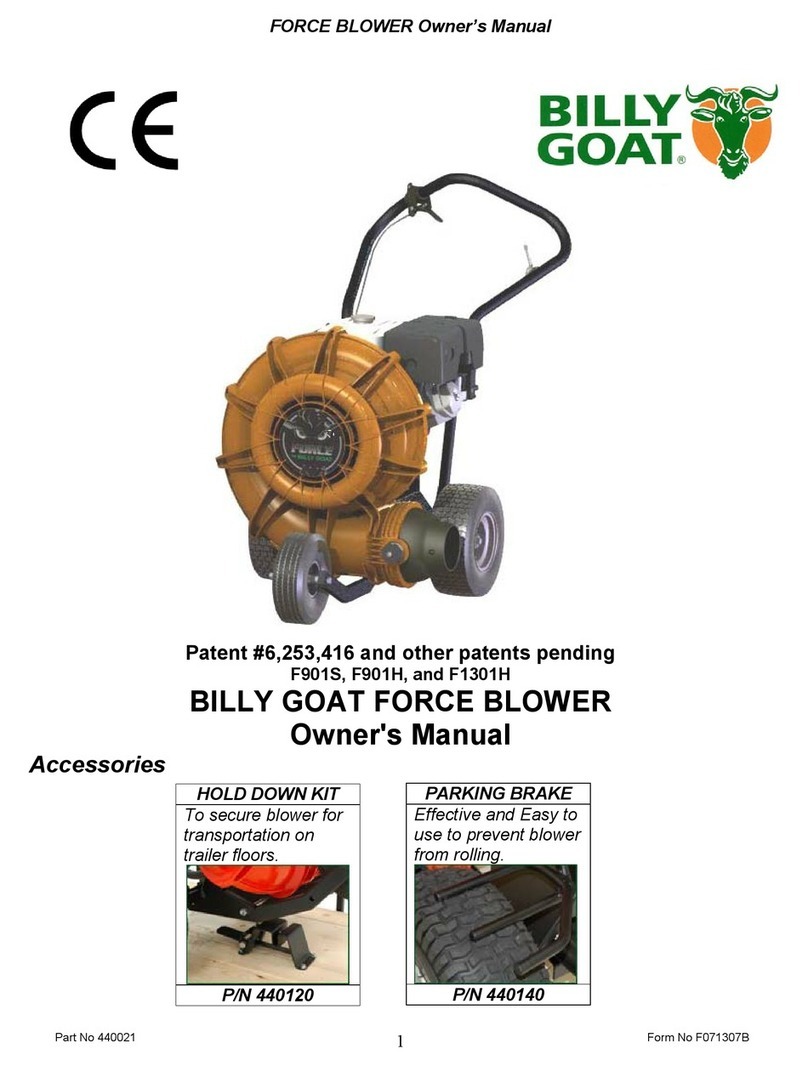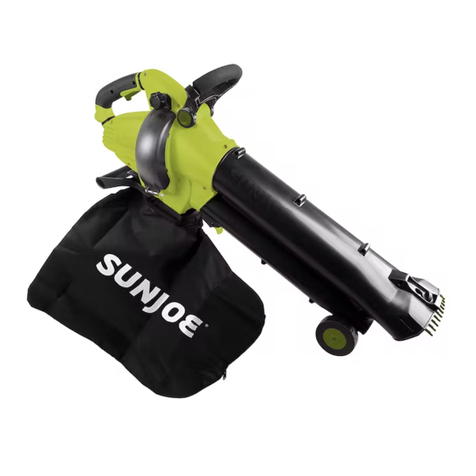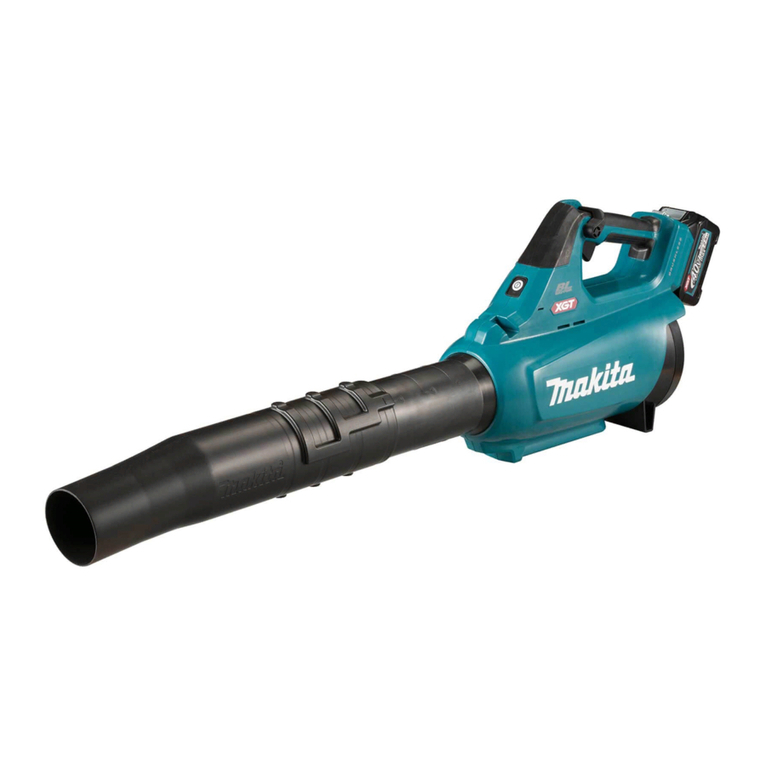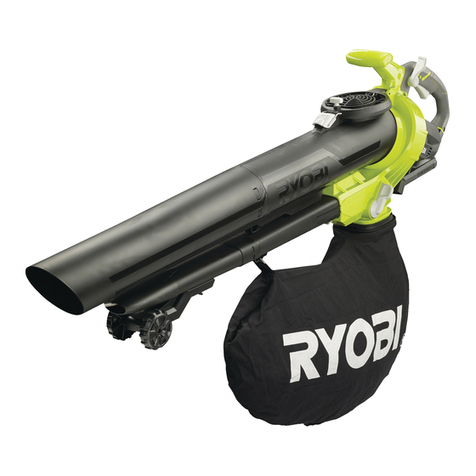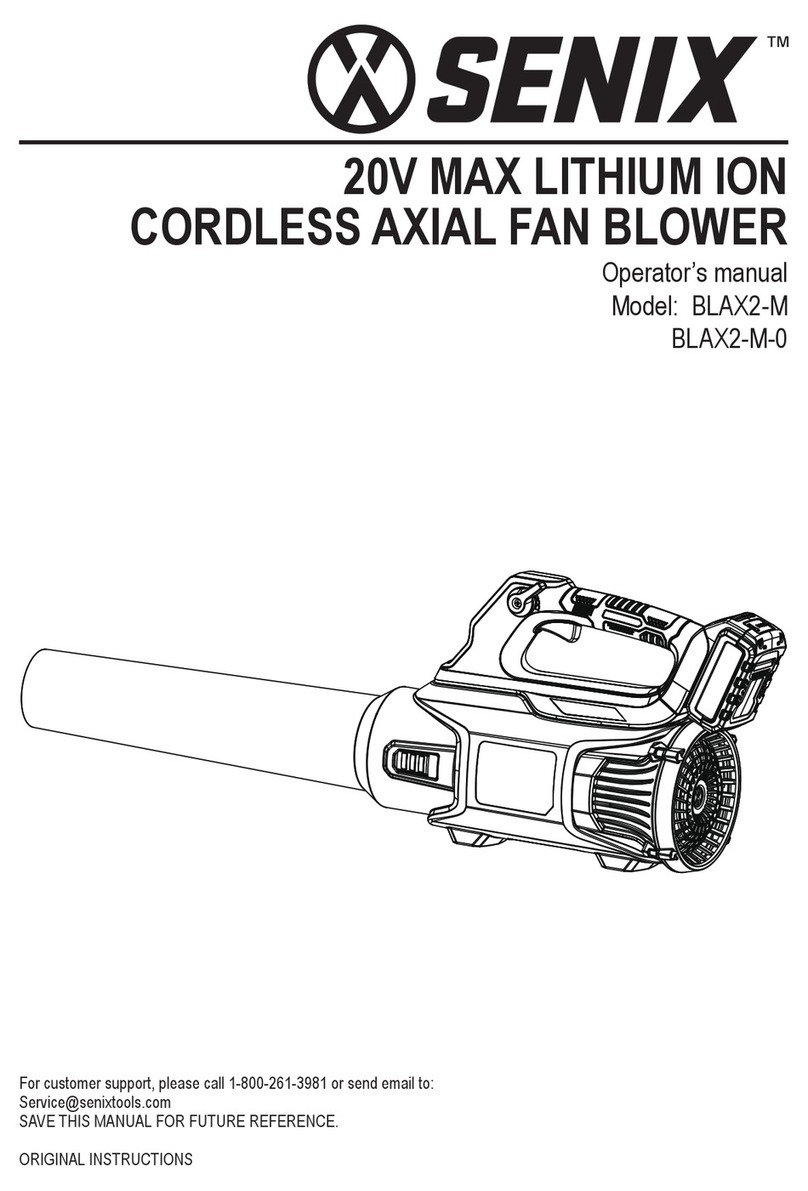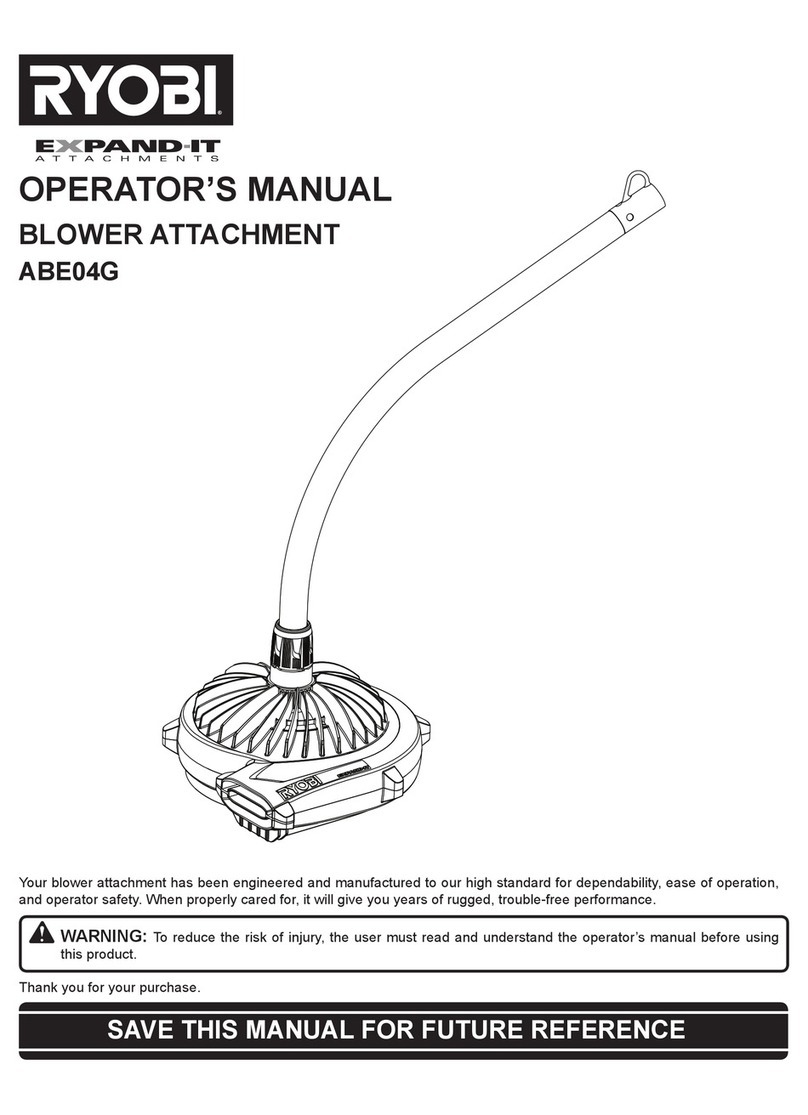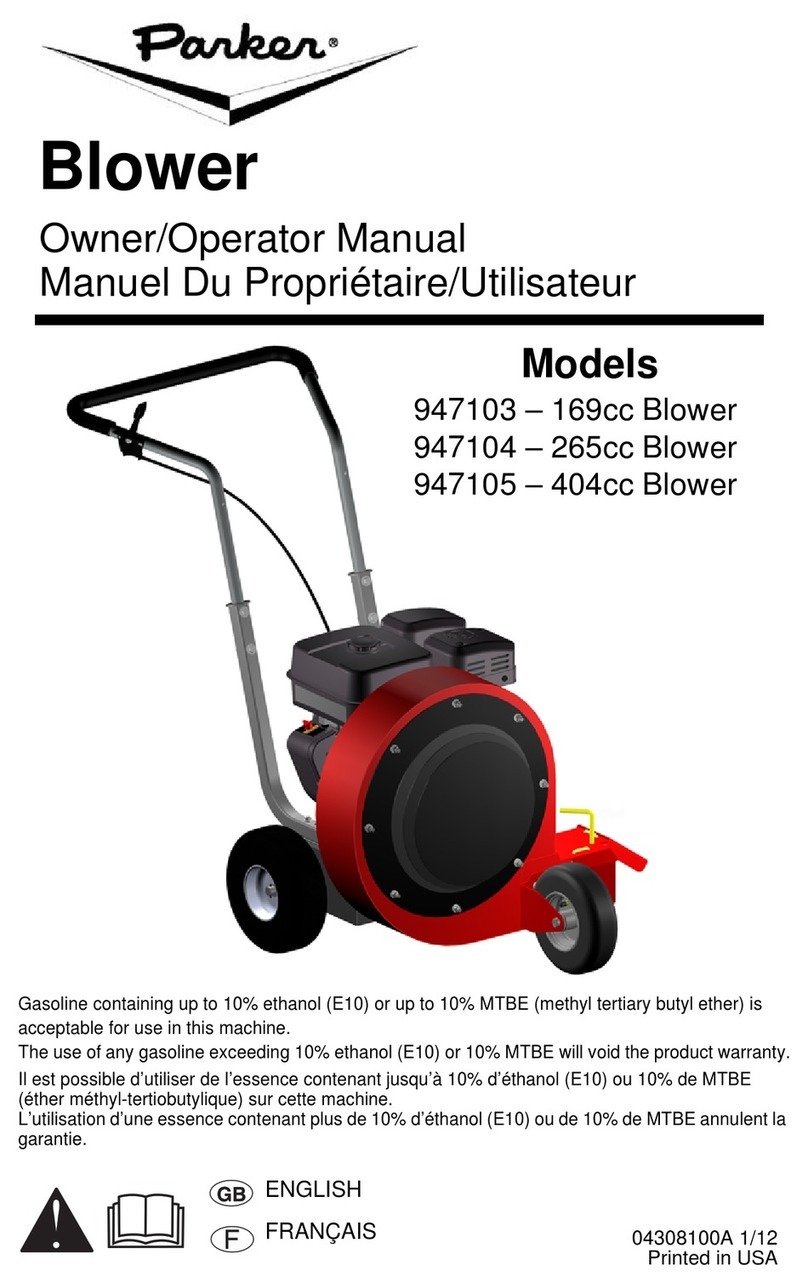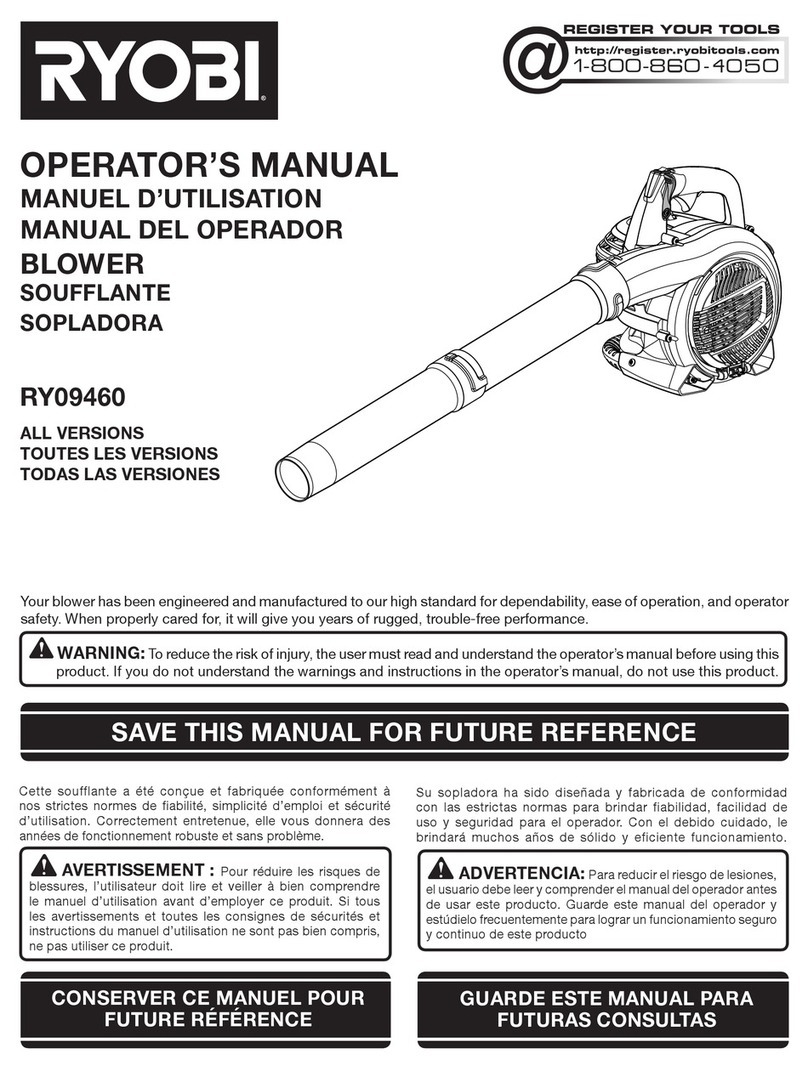TOOLSTATION HAWKSMOOR CBV18W.1 User manual

18V
LITHIUM
PLEASE KEEP THESE INSTRUCTIONS FOR FURTHER REFERENCE
WHAT’S IN THE BOX
If you do not have all these items, please contact:
www.toolstation.com/contact
Telephone 0345 6460997
Email [email protected]
18V
LITHIUM
Battery pack x1
Blower x1
Charger x1
Original User’s Instructions
18V Cordless Turbine Blower
SKU: 91377

TECHNICAL DATA
Sku/Model 91377/CBV18W.1
Rated voltage 18 V
Air volume 11.3m³/min, 8.5m³/min
Air speed 131km/h, 99km/h
No load speed 19500/min
Protection Class /II
Battery Capacity (ABP1820SW) 2.0 Ah
Charger Input (ACG118W3) 100-240V ~ 50/60Hz, 55W
Charger Output (ACG118W3) 20 V , 2.0 A
Charging Time 1 hr
Machine Weight 2.79 kg
• Variable speed design
• High capacity air volume with turbine fan technology
• Lightweight and ergonomic one-hand operation
• Rubber overmould grip
ACCESSORIES
Battery pack 1
Charger 1
SPECIFICATION

NOISE INFORMATION
A weighted sound pressure LpA =84 dB(A)
KpA= 3.0 dB(A)
A weighted sound power LwA =101.1 dB(A)
KwA= 3.0 dB(A)
Wear ear protection.
VIBRATION INFORMATION
Vibration emission value:
ah<2.5m/s2Uncertainty K =1.5m/s²
The declared vibration total value may be used for comparing one tool with another, and may also be
used in a preliminary assessment of exposure.
WARNING: The vibration emission value during actual use of the power tool can differ from the
declared value depending on the ways in which the tool is used dependant on the following
examples and other variations on how the tool is used:
How the tool is used and the materials being cut or drilled.
The tool being in good condition and well maintained.
Using the correct accessory for the tool and ensuring it is sharp and in good condition.
The tightness of the grip on the handles and if any anti vibration accessories are used.
And the tool is being used as intended by its design and these instructions.
This tool may cause hand-arm vibration syndrome if its use is not adequately managed.
WARNING: To be accurate, an estimation of exposure level in the actual conditions of use
should also take account of all parts of the operating cycle such as the times when the tool is
switched off and when it is running idle but not actually doing the job. This may signicantly reduce the
exposure level over the total working period.
Helping to minimise your vibration exposure risk.
ALWAYS use sharp chisels, drills and blades.
Maintain this tool in accordance with these instructions and keep well lubricated (where appropriate).
If the tool is to be used regularly then invest in anti vibration accessories.
Plan your work schedule to spread any high vibration tool use across a number of days.

EXPLANATIONS AND SYMBOLS, CAUTIONS AND WARNINGS
Li-I on
Read the operator’s manual
Wear eye protection
Keep bystanders away
Warning of hazard
Do not expose to rain
Make sure the battery is removed prior to changing accessories.
Do not dispose of batteries, Return exhausted batteries to your local
collection or recycling point.

T 2A
Do not expose to rain or water
Do not burn
Waste electrical products must not be disposed of with household waste.
Please recycle where facilities exist. Check with your local authorities or
retailer for recycling advice.
For indoor use only (Only for charger)
Positive terminal (Only for charger)
Negative terminal (Only for charger)
Fuse (Only for charger)
Double insulation (Only for charger)
CE marking
UKCA marking

HEALTH AND SAFETY
ORIGINAL INSTRUCTION
PRODUCT SAFETY
WARNING: Read all safety warnings and all instructions.
Failure to follow the warnings and instructions may result in
electric shock, re and/or serious injury.
Save all warnings and instructions for future reference.
The appliance is only to be used with the power supply unit
provided with the appliance.
IMPORTANT
READ CAREFULLY BEFORE USE.
KEEP FOR FUTURE REFERENCE.
SAFE OPERATING PRACTICES
1) Training
a) Read the instructions carefully. Be familiar with the controls and the
correct use of the machine.
b) Never allow children, persons with reduced physical, sensory or
mental capabilities or lack of experience and knowledge or people
unfamiliar with these instructions to use the machine, local regulations
may restrict the age of the operator.
c) Never operate the machine while people, especially children, or pets
are nearby.
d) Keep in mind that the operator or user is responsible for accidents or
hazards occurring to other people or their property.
2) Preparation
a) While operating the machine, always wear substantial footwear and
long trousers. Do not operate the machine when barefoot or wearing
open sandals. Avoid wearing clothing that is loose tting or that has
hanging cords or ties.
b) Do not wear loose clothing or jewellery that can be drawn into the air
inlet. Keep long hair away from the air inlets.
c) Obtain ear protection and safety glasses. Wear them at all times while
operating the machine.
d) Operate the machine in a recommended position and only on a rm,
level surface.
e) Do not operate the machine on a paved or gravel surface where
ejected material could cause injury.
f) Before using, always visually inspect to see, that the fasteners are
secure, the housing is undamaged and that guards and screens are

in place. Replace worn or damaged components in sets to preserve
balance. Replace damaged or unreadable labels.
3) Operation
a) Before starting the machine, make certain that the feeding chamber is
empty.
b) Keep your face and body away from the feed intake opening.
c) Do not allow hands or any other part of the body or clothing inside the
feeding chamber, discharge chute, or near any moving part.
d) Keep proper balance and footing at all times. Do not overreach. Never
stand at a higher level than the base of the machine when feeding
material into it.
e) Always stand clear of the discharge zone when operating this
machine.
f) If the machine should start making any unusual noise or vibration,
immediately shut off the power source and allow the machine to stop.
Remove the battery pack from the machine and take the following
steps before restarting and operating the machine:
i) inspect for damage;
ii) replace or repair any damaged parts;
iii) check for and tighten any loose parts.
g) Do not allow processed material to build up in the discharge zone;
this may prevent proper discharge and can result in kickback of
material through the intake opening.
h) If the machine becomes clogged, shut-off the power source and
remove the battery pack from the machine before cleaning debris.
i) Never operate the machine with defective guards or shields, or
without safety devices.
j) Keep the power source clean of debris and other accumulations to
prevent damage to the power source or possible re.
k) Do not transport this machine while the power source is running.
l) Always disconnect the machine from the power supply (e.g. remove
the battery pack from the machine)
- whenever you leave the machine,
- before clearing blockages or unclogging chute,
- before checking, cleaning or working on the machine.
m) Avoid using the machine in bad weather conditions especially when
there is a risk of lightning.
4) Maintenance and storage
a) Keep all nuts, bolts and screws tight to be sure the appliance is in
safe working condition.
b) Replace worn or damaged parts.
c) Use only genuine replacement parts and accessories.

d) Store the machine in a dry place out of the reach of children.
e) When the machine is stopped for servicing, inspection, or storage, or
to change an accessory, shut off the power source, disconnect the
machine from the supply and make sure that all moving parts are
come to a complete stop. Allow the machine to cool before making
any inspections, adjustments, etc. Maintain the machine with care
and keep it clean.
f) Store the machine in a dry place out of the reach of children.
g) Always allow the machine to cool before storing.
h) Never attempt to override the interlocked feature of the guard.
SAFETY WARNINGS FOR BATTERY PACK
a) Do not dismantle, open or shred cells or battery pack.
b) Do not short-circuit a battery pack. Do not store battery packs
haphazardly in a box or drawer where they may short-circuit
each other or be short-circuited by conductive materials. When
battery pack is not in use, keep it away from other metal objects, like
paper clips, coins, keys, nails, screws or other small metal objects,
that can make a connection from one terminal to another. Shorting
the battery terminals together may cause burns or a re.
c)Donotexposebatterypacktoheatorre.Avoidstoragein
direct sunlight.
d) Do not subject battery pack to mechanical shock.
e) In the event of battery leaking, do not allow the liquid to come
into contact with the skin or eyes. If contact has been made,
wash the affected area with copious amounts of water and seek
medical advice.
f) Seek medical advice immediately if a cell or battery pack has
been swallowed.
g) Keep battery pack clean and dry.
h) Wipe the battery pack terminals with a clean dry cloth if they
become dirty.
i) Battery pack needs to be charged before use. Always refer to
this instruction and use the correct charging procedure.
j) Do not maintain battery pack on charge when not in use.
k) After extended periods of storage, it may be necessary to
charge and discharge the battery pack several times to obtain
maximum performance.
l) Battery pack gives its best performance when it is operated at
normal room temperature (20 °C ± 5 °C).
m)When disposing of battery packs, keep battery packs of different
electrochemical systems separate from each other.
n)Rechargeonlywiththechargerspeciedbymanufacturer.Do

notuseanychargerotherthanthatspecicallyprovided
for use with the equipment. A charger that is suitable for one
type of battery pack may create a risk of re when used with
another battery pack.
o) Do not use any battery pack which is not designed for use
with the equipment.
p) Keep battery pack out of the reach of children.
q) Retain the original product literature for future reference.
r) Remove the battery from the equipment when not in use.
s) Dispose of properly.
t) Do not mix cells of different manufacture, capacity, size or
type within a device.
u) Do not remove battery pack from its original packaging
until required for use.
v) Observe the plus (+) and minus (–) marks on the battery
and ensure correct use.
GENERAL SAFETY WARNINGS
WARNING! Read all safety warnings and all
instructions.
Failure to follow the warnings and
instructions may result in electric shock, re and/or serious
injury.
Save all warnings and instructions for future reference.
This appliance can be used by children aged from 8 years and
above and persons with reduced physical, sensory or mental
capabilities or lack of experience and knowledge if they have
been given supervision or instruction concerning use of the
appliance in a safe way and understand the hazards involved.
Children shall not play with the appliance. Cleaning and user
maintenance shall not be made by children without supervision.
If the supply cord is damaged, It must be replaced by the
manufacturer, its service agent or similarly qualied persons in
order to avoid a hazard.
Additional safety instructions for your Battery Charger
1. Before charging, read the instructions.
2. Do not charge a leaking battery.
3. Do not use chargers for works other than those for which
they are designed.
4. Before charging, ensure your charger is matching the local

AC supply.
5. For indoor use, or do not expose to rain.
6. The charging device must be protected from moisture.
7. Do not use the charging device outdoors.
8. Do not short out the contacts of battery or charger.
9. Respect the polarity “+/-“ when charging.
10. Do not open the unit and keep it out of the reach of children.
11. Do not charge the batteries of other manufactures or ill-suited
models.
12. Ensure that the connection between the battery charger and
battery is correctly positioned and is not obstructed by foreign
bodies.
13. Keep battery charger’s slots free of foreign objects and protect
against dirt and humidity. Store in a dry and frost-free place.
14. When charging batteries, ensure that the battery charger is in
a well-ventilated area and away from inammable materials.
Batteries can get hot during charging. Do not overcharge
any batteries. Ensure that batteries and chargers are not left
unsupervised during charging.
15. Do not recharge non-rechargeable batteries, as they can
overheat and break.
16. Longer life and better performance can be obtained if the battery
pack is charged when the air temperature is between 18oC and
24oC. Do not charge the battery pack in air temperatures below
0oC, or above 40oC. This is important as it can prevent serious
damage to the battery pack.
17. Charge only battery pack of the same model provided by
manufacturer and of models recommended by manufacturer.

COMPONENT LIST
1. Lower tube
2. Upper tube
3. Fan housing
4. ON/OFF switch
5. Main handle
6. Battery pack release button
7. Battery pack
8. Motor housing
9. Tube release button
12345
6
7
8
9
18V
LITHIUM

To reduce the risk of injury, user must read instruction
manual
Intended Use
The blower is intended for residential use only. Use the blower
outdoors to move yard debris as needed.
1. ASSEMBLING AND DISASSEMBLING THE BLOWER TUBE
(SEE FIG. A1 & A2)
NOTE:
Before assembling and disassembling the Blower Tube, be sure
the on/off switch is in ‘’0’’ Off position and the battery is removed.
Slide the lower blower tube to upper blower tube and slide blower
tube to the motor housing as shown in Fig. A1 . Ensure the hole in
the tube matches up with the tube release button in the housing.
Press the tube release button, so that you can separate the tube
(See Fig. A2). Do not try to separate the tubes by force or by
using tools.
d
b
c
Click
Click
ON OFF
II
I
1
2
B
C1
A2
A1
D
E
F
C2
BEFORE OPERATION
Warning: The charger (b) and battery pack (c) are
specially designed to work together so do not attempt to
use any other devices. Never insert or allow metallic objects into
your charger or battery pack connections because of an electrical
failure and hazard will occur.
NOTE:
a) Do not use any charger other than that specically provided
for use with the equipment.
b) If the battery pack is very hot you must remove your battery
pack from the charger and allow time for the battery to cool
down before recharging.
c) The battery in your new tool is not charged when it leaves
the plant. Therefore it must be full charged before using the rst
time
d) Please charge the battery to reach full or no less than half
charge before storage. If the tool will not be used for long
periods of time, charge the battery every 3-6 months.
1. CHARGING PROCEDURE (SEE FIG. B)
1) Connect the battery charger to the power supply and the
indicator light should turn green.
2) Slide the charger base on the battery pack make connections
and the indicator light (d) will turn red to show that the charging
has started.
3) When charging is completed, the light will turn green. The
pack is now fully charged, unplug the charger and remove the
battery pack.
WARNING! When battery charge runs out after
continuously use or exposure to direct sunlight or heat,
allow time for the tool to cool down before re-charging to achieve
the full charge.
d
b
c
Click
Click
ON OFF
II
I
1
2
B
C1
A2
A1
D
E
F
C2
ASSEMBLY AND USE

Light Status
Red on Charging
Green on Fully Charged
2. TO REMOVE OR INSTALL BATTERY PACK (SEE FIG.C1,
C2)
Depress the battery pack release button to release battery pack
from your hedge trimmer. (See Fig. C1) After recharging, insert the
battery pack into hedge trimmer’s battery port. A simple push and
slight pressure will be sufcient. (See Fig. C2)
NOTE: When removing the battery pack, hold it rmly to avoid
potential accidents.
OPERATION
1. STARTING AND STOPPING (SEE FIG. D)
Starting
Move the On/Off switch (2) to the “I” or “II” On position.
Stopping
Move the On/Off switch (2) to the “0” Off position.
WARNING!
The tool runs for a few seconds after it has
been switched off.
NOTE: Let the motor come to a complete standstill before setting
the tool down.
2. BLOWING(SEE FIG. E, F)
USER TIPS
- Adjusting the Blowing Speed (I or II) according to the desired
working condition.
-Hold the blow tube approximately 8” above the ground when
operating the tool.
-Use a sweeping motion from side to side. Advance slowly
keeping the accumulated debris/leaves in front of you.
- After blowing the debris/leaves into a pile, it is easy to dispose of
the pile.
Caution!
- Do not blow hard objects such as nails, bolts, or rocks.
- Do not operate the blower near bystanders or pets.
- Use extra care when cleaning debris from stairs or other
tight areas.
- Wear safety goggles or other suitable eye protection, long
pants, and shoes.
d
b
c
Click
Click
ON OFF
II
I
1
2
B
C1
A2
A1
D
E
F
C2

Clean the tool regularly.
WARNING! Keep your product dry. Under no circumstances spray with water.
- To clean the tool, use only mild soap and a damp cloth.
- Do not use any type of detergent, cleaner or solvent which may contain chemicals that could
seriously damage the plastic.
- Self lubricating bearings are used in your product, therefore lubrication is not required.
CARE AND CLEANING
TROUBLE SHOOTING
Use this section to help you to try and solve any problems you may have:
PROBLEM POSSIBLE CAUSE CORRECTIVE ACTION
Blower fails to operate. Out of battery. Check battery pack assembly.
Charge the battery pack.
Battery fails to charge. Wrong assembly
Insert battery into the charger base.
Check the plug and fuse connected
with supply.
Suspected fault Damaged machine Return the blower to an authorized
dealer for repair.
NOTE: IF YOU EXPERIENCE A PROBLEM WITH YOUR TOOL, PLEASE DO NOT ATTEMPT
TO OPEN OR REPAIR THE TOOL YOURSELF. DOING SO MAY VOID THE WARRANTY AND
COULD CAUSE DAMAGE OR PERSONAL INJURY. IF THE PROBLEM STILL PERSISTS,
PLEASE CONTACT US BY REFERRING TO THE SERVICE & SUPPORT INFORMATION ON THE
FOLLOWING PAGE.

Product Code: 91377 (CBV18W.1)
Product Description: 18V Cordless Turbine Blower
1. Toolstation Limited, Express Park, Bristol Road, Bridgwater, Somerset TA6 4RN
This declaration of conformity is issued under the sole responsibility of Toolstation
2. Object of the declaration
The object of the declaration described above is in conformity with the relevant Community
harmonization legislation:
Supply of Machinery (Safety) Regulations 2008
2006/42/EC
Electromagnetic Compatibility Regulations 2016
2014/30/EU
Electrical Equipment (Safety) Regulations 2016
2014/35/EU
The Restriction of the Use of Certain Hazardous Substances in Electrical and Electronic Equipment
Regulations 2012
2011/65/EU&(EU)2015/863
Noise Emission in the Environment by Equipment for use Outdoors Regulations 2001
2000/14/EC amended by 2005/88/EC
2000/14/EC amended by 2005/88/EC:
- Conformity Assessment Procedure as per Annex V
- Measured Sound Power Level 100 dB(A)
- Declared Guaranteed Sound Power Level 102 dB(A)
3. References to the relevant standards used (or references to the specications in relation to which
conformity is declared:
BS EN 60335-1, BS EN 50636-2-100, BS EN 62233, BS EN ISO 3744, BS EN 55014-1,
BS EN 55014-2, BS EN 60335-2-29, BS EN 61000-3-2, BS EN 61000-3-3, BS EN 60950-1
4. Additional information:
Signed for and on behalf of Toolstation Limited
Paul Field 01/01/2021
DECLARATION OF CONFORMITY / PERFORMANCE

When your heater comes to the end of its life or you choose to update or upgrade it by
replacing it, please do not dispose of it with your normal household waste. Please recycle
where facilities exist. When you need to dispose of this heater, check with your retailer or
local authority for suitable options. Regulations encourage the recycling of Waste from Electrical
and Electronic Equipment (DIRECTIVE 2012/19/EU OF THE EUROPEAN PARLIAMENT AND OF
THE COUNCIL of 4 July 2012 on waste electrical and electronic equipment (WEEE)).
ENVIRONMENTAL INFORMATION

Toolstation products deliver reliable service for normal, household use in domestic settings. All Toolstation
products are individually tested before leaving the factory.
If you are a consumer and you experience a problem with your Toolstation product, which is found to be
defective due to faulty materials or workmanship within the Guarantee Period, this Toolstation Guarantee
will cover repair or - at the discretion of Toolstation – replacement with a functionally equivalent Toolstation
product.
Your product is under guarantee for 2 years from the date of purchase or the date of delivery of the product, if
later.
The guarantee is subject to the following provisions:
- The guarantee does not cover accidental damage, misuse, cabinet parts, knobs, or consumable items.
- The product must be correctly installed and operated in accordance with the instructions contained in this
manual.
- It must be used solely for domestic purpose.
- The guarantee will be retendered invalid if the product is re-sold or has been damaged by inexpert repair.
- Specications are subject to change without notice.
- The manufacturer disclaims any liability for the incidental or consequential damages.
- The guarantee is in addition to, and does not diminish your statutory or legal rights.
CUSTOMER SUPPORT
www.toolstation.com/contact
Telephone 0345 6460997
Email: [email protected]
Made in China
GUARANTEE



This manual suits for next models
1
Table of contents
Popular Blower manuals by other brands
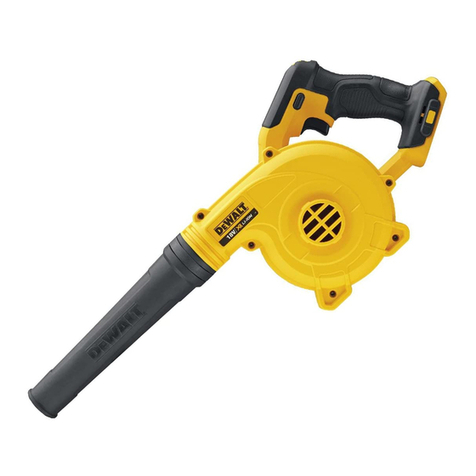
DeWalt
DeWalt DCV100 instruction manual
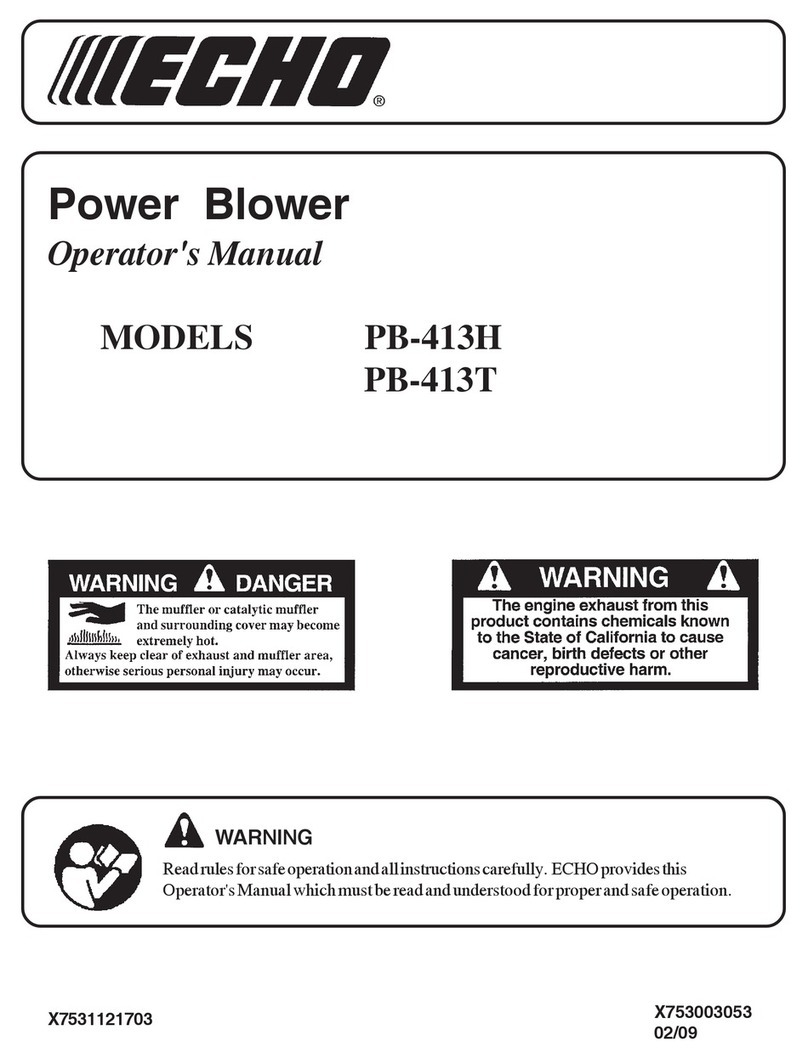
Echo
Echo PB-413H - 02-09 Operator's manual
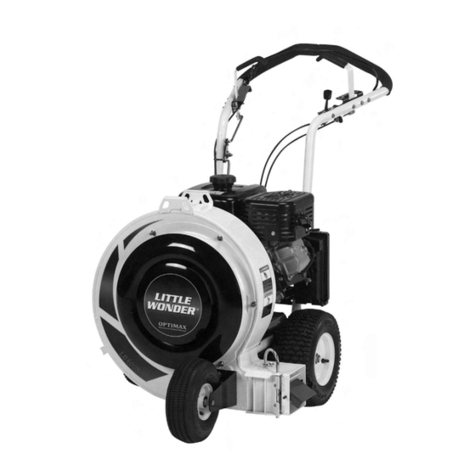
Little Wonder
Little Wonder Optimax 9270-12-59 Owner's manual and safety instructions
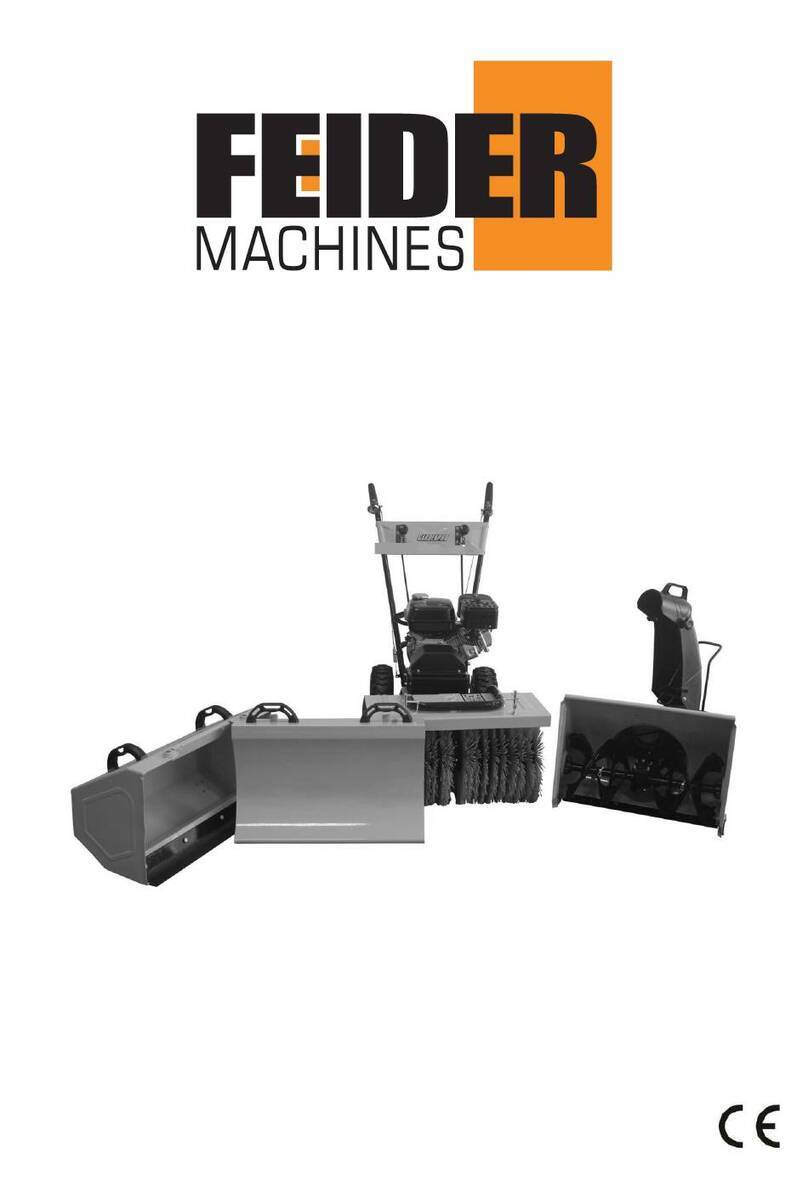
Feider Machines
Feider Machines FBAE200-1 instruction manual

Toro
Toro Versa Vac Operator's manual
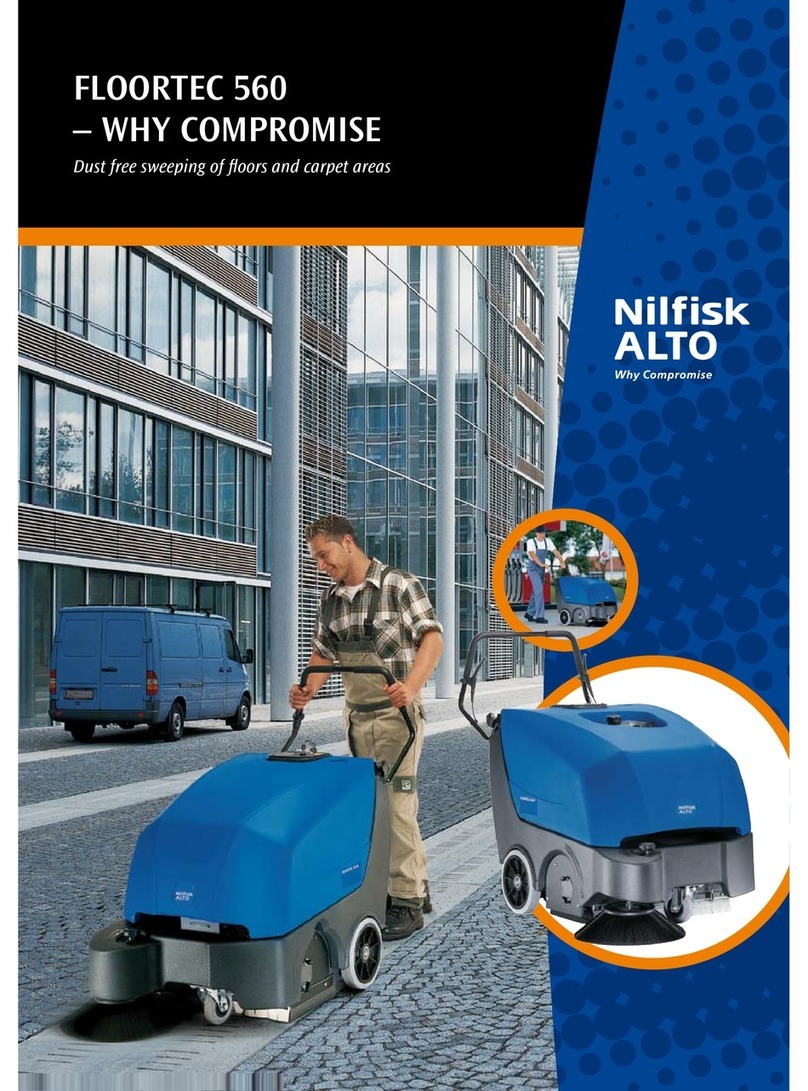
Nilfisk-ALTO
Nilfisk-ALTO Floortec 560 B Brochure & specs

